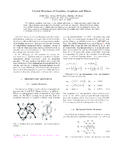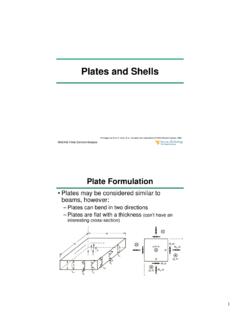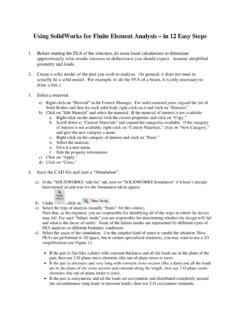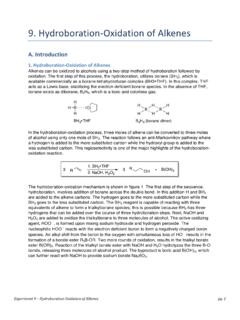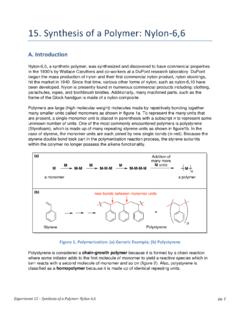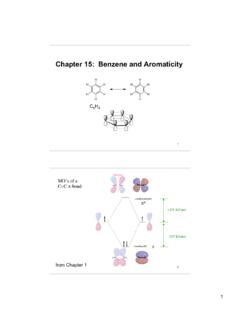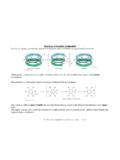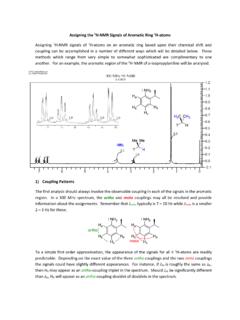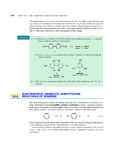Transcription of 16. Electrophilic Aromatic Substitution
1 Experiment 16 Electrophilic Aromatic Substitution Page 1 of 8 16. Electrophilic Aromatic Substitution A. Introduction Aromatic compounds are especially stable and despite having p-bonds do not react like typical alkenes. For example, the p-bond in 1-hexene undergoes bromination to give 1,2-dibromohexane, while benzene does not react under similar conditions (figure 1). Figure 1. Bromination of Alkenes Aromatic compounds are extremely important for their industrial and pharmaceutical use. A few prescription drugs containing one or more Aromatic rings are shown in figure 2.
2 With their immense value as synthetic targets, it is important to understand both the properties and the reactivity of Aromatic rings. By tapping into the reactions of Aromatic rings, a simple benzene ring can be highly functionalized to provide complex organic molecules. The focus of this experiment is on Electrophilic Substitution of benzene rings (shown in blue in figure 2), however, a variety of other Aromatic rings (shown in red in figure 2) do exist, and bring an entirely different breadth of properties to these molecules. Figure 2.
3 Pharmaceutical Compounds Containing Aromatic Functionality Although benzene does not react with bromine alone, it was found that by adding a Lewis acid (FeBr3) to the reaction mixture, benzene could be mono-brominated in relatively high yield. Addition of the Lewis acid enhances the electrophilicity of the bromine to such a degree that one can overcome the low reactivity inherent to benzene. The reaction mechanism first involves generation of the active electrophile by coordination of bromine with iron tribromide. This Lewis acid-base adduct provides a source for the highly Electrophilic bromonium ion (Br ).
4 The Br2 BrBrBr2 NoReactionOOHOHOHNFNHOL ipitorused for treating high cholesterolNHNSONOON exiuma proton pump inhibitor used to treat acid refluxHNClClZoloftused for treating depressionExperiment 16 Electrophilic Aromatic Substitution Page 2 of 8 second part of the mechanism involves reaction of the benzene p-bond with either the Lewis acid-base adduct (shown) or simply with Br to provide a carbocation intermediate. This step temporarily breaks the aromaticity in the ring. Bromide (Br ), from FeBr4 then acts as a base removing a proton from the ring to form a p-bond and reestablishing aromaticity.
5 This overall process is referred to as an Electrophilic Aromatic Substitution (EAS) because a hydrogen on the Aromatic ring is substituted with an electrophile, such as Br. (Figure 3) Figure 3. Electrophilic Bromination of Benzene A variety of conditions can be employed to obtain severed different mono-substituted benzene rings. Table 1 lists the five most common Electrophilic Aromatic Substitution reactions. Table 1. Typical Conditions for Electrophilic Aromatic Substitution Br2 FeBr3 BrBrBr+FeBr3 BrBrFeBr3 Reaction Mechanism1. Generation of the active electrophile2.
6 Reaction of benzene with the active electrophileBrBrFeBr3+H+HBrBrFeBr3Br+ HBr+ FeBr375%BrFeBr3+BrBr2 FeBr3 PhHConditionsActive ElectrophileProductCl2 FeCl3 HNO3H2SO4SO3H2SO4R-ClAlCl3 BrClNO2SO3 HRPhBrPhClPhNO2 PhSO3 HPhRPhHPhHPhHPhHExperiment 16 Electrophilic Aromatic Substitution Page 3 of 8 Disubstituted Benzene Terminology The terms ortho, meta, and para are frequently used to describe the locational relationship between two substituents on an Aromatic ring. Two substituents in a 1,2 relationship are said to be ortho, two substituents in a 1,3 relationship are said to be meta, and two substituents in a 1,4 relationship are said to be para.
7 (Figure 4) Figure 4. Ortho, Meta, and Para Terminology Directing Group Effects When an Aromatic ring contains a substituent, that substituent affects the nucleophilicity and therefore reactivity of the Aromatic ring. Some substituents activate the ring, making it more reactive than benzene alone, while other substituents deactivate the ring, making it less reactive than benzene. Figure 5 lists some common activating and deactivating groups. These groups can be generalized in the following way: Activating groups typically contain a lone pair on the atom that is directly attached to the Aromatic ring.
8 Alkyl groups are one exception, however, and are only weakly activating. Deactivating groups on the other hand have a halogen or electron withdrawing group, such as C=O, directly attached to the Aromatic ring. Figure 5. Common Activating and Deactivating Groups Activating groups enhance the nucleophilicity and reactivity of the ring by resonance donation as shown in figure 6a. Deactivating groups on the other hand, decrease the nucleophilicity and reactivity of the ring by resonance and/or inductive withdraw of electron density from the Aromatic ring as shown in figure 6b.
9 CH3CH3CH3CH3CH3CH312341,4-dimethylbenzen epara-diemthylbenzene121,2-dimethylbenze neortho-diemthylbenzene1231,3-dimethylbe nzenemeta-diemthylbenzene*dimethylbenzne is also called xyleneOHNH2 NHRNR2 ORNHROORORHFClBrIOHOORCNNO2SO3 HNR3 Strongly ActivatingModerately Activating(Benzene: Standard of Comparison)ActivatingGroupsDeactivatingG roupsortho, para directorsmeta directorsExperiment 16 Electrophilic Aromatic Substitution Page 4 of 8 Figure 6. Resonance Effect of Activating and Deactivating Groups It is also important to note that when an Electrophilic Aromatic Substitution reaction is performed on a mono-substituted benzene ring containing an activating group, the new electrophile will add to the ortho and the para positions of the ring (figure 7a).
10 In the case of most deactivating groups on the ring, the electrophile will add to the meta position (figure 7b). The origin of this selectivity will be discussed in the next section. Figure 7. Directing Group Effects in Electrophilic Aromatic Substitution Aromatic rings containing very strongly activating groups such as OH (phenol) and NH2 (aniline) can actually be halogenated in the absence of a Lewis acid catalyst. In fact, these strongly activated Aromatic rings are so highly activated that it is difficult to stop at mono-halogenation.
